Biosynthesis of the Inner Core of Bordetella pertussis Lipopolysaccharides: Effect of Mutations on LPS Structure, Cell Division, and Toll-like Receptor 4 Activation
Abstract
:1. Introduction

2. Results
2.1. Targeting the Phosphate Groups of B. pertussis Lipid A
2.2. Modification of the Inner Core of B. pertussis LPS Using KdtAEc
2.3. Phenotypic Characterization of KdtAEc-Producing Strains
2.4. Identification and Characterization of the eptB Gene in B. pertussis
2.5. TLR4 Activation by Inner-Core-Modified Derivatives of B. pertussis
3. Discussion
4. Materials and Methods
4.1. Bacterial Strains and Growth Conditions
4.2. DNA Manipulation and Plasmid Construction
4.3. LC-MS
4.4. OM Isolation
4.5. Kdo Assay
4.6. SDS-PAGE and Western Blotting
4.7. Microscopy
4.8. LPS Isolation and Heptose Quantification
4.9. TLR4 Stimulation Assays
4.10. Statistical Analysis
Supplementary Materials
Author Contributions
Funding
Institutional Review Board Statement
Informed Consent Statement
Data Availability Statement
Acknowledgments
Conflicts of Interest
References
- Mattoo, S.; Cherry, J.D. Molecular pathogenesis, epidemiology, and clinical manifestations of respiratory infections due to Bordetella pertussis and other Bordetella subspecies. Clin. Microbiol. Rev. 2005, 18, 326–382. [Google Scholar] [CrossRef] [PubMed]
- Esposito, S.; Stefanelli, P.; Fry, N.K.; Fedele, G.; He, Q.; Paterson, P.; Tan, T.; Knuf, M.; Rodrigo, C.; Weil Olivier, C.; et al. Pertussis prevention: Reasons for resurgence, and differences in the current acellular pertussis vaccines. Front. Immunol. 2019, 10, 1344. [Google Scholar] [CrossRef] [PubMed]
- Silhavy, T.J.; Kahne, D.; Walker, S. The bacterial cell envelope. Cold Spring Harb. Perspect. Biol. 2010, 2, a000414. [Google Scholar] [CrossRef] [PubMed]
- Raetz, C.R.H.; Whitfield, C. Lipopolysaccharide endotoxins. Annu. Rev. Biochem. 2002, 71, 635–700. [Google Scholar] [CrossRef] [PubMed]
- Parrillo, J.E. Pathogenetic mechanisms of septic shock. N. Engl. J. Med. 1993, 328, 1471–1477. [Google Scholar] [CrossRef] [PubMed]
- Park, B.S.; Song, D.H.; Kim, H.M.; Choi, B.S.; Lee, H.; Lee, J.O. The structural basis of lipopolysaccharide recognition by the TLR4–MD-2 complex. Nature 2009, 458, 1191–1195. [Google Scholar] [CrossRef]
- Raetz, C.R.H.; Reynolds, C.M.; Trent, M.S.; Bishop, R.E. Lipid A modification systems in Gram-negative bacteria. Annu. Rev. Biochem. 2007, 76, 295–329. [Google Scholar] [CrossRef]
- Matsuura, M. Structural modifications of bacterial lipopolysaccharide that facilitate Gram-negative bacteria evasion of host innate immunity. Front. Immunol. 2013, 4, 109. [Google Scholar] [CrossRef]
- Geurtsen, J.; Steeghs, L.; Hamstra, H.J.; ten Hove, J.; de Haan, A.; Kuipers, B.; Tommassen, J.; van der Ley, P. Expression of the lipopolysaccharide-modifying enzymes PagP and PagL modulates the endotoxic activity of Bordetella pertussis. Infect. Immun. 2006, 74, 5574–5585. [Google Scholar] [CrossRef]
- Arenas, J.; Pupo, E.; Phielix, C.; David, D.; Zariri, A.; Zamyatina, A.; Tommassen, J.; van der Ley, P. Shortening the lipid A acyl chains of Bordetella pertussis enables depletion of lipopolysaccharide endotoxic activity. Vaccines 2020, 8, 594. [Google Scholar] [CrossRef]
- Marr, N.; Tirsoaga, A.; Blanot, D.; Fernandez, R.; Caroff, M. Glucosamine found as a substituent of both phosphate groups in Bordetella lipid A backbones: Role of a BvgAS-activated ArnT ortholog. J. Bacteriol. 2008, 190, 4281–4290. [Google Scholar] [CrossRef]
- Wang, X.; Karbarz, M.J.; McGrath, S.C.; Cotter, R.J.; Raetz, C.R.H. MsbA transporter-dependent lipid A 1-dephosphorylation on the periplasmic surface of the inner membrane: Topography of Francisella novicida LpxE expressed in Escherichia coli. J. Biol. Chem. 2004, 279, 49470–49478. [Google Scholar] [CrossRef] [PubMed]
- Wang, X.; McGrath, S.C.; Cotter, R.J.; Raetz, C.R.H. Expression cloning and periplasmic orientation of the Francisella novicida lipid A 4′-phosphatase LpxF. J. Biol. Chem. 2006, 281, 9321–9330. [Google Scholar] [CrossRef] [PubMed]
- Kong, Q.; Six, D.A.; Roland, K.L.; Liu, Q.; Gu, L.; Reynolds, C.M.; Wang, X.; Raetz, C.R.H.; Curtiss, R., 3rd. Salmonella synthesizing 1-dephosphorylated lipopolysaccharide exhibits low endotoxic activity while retaining its immunogenicity. J. Immunol. 2011, 187, 412–423. [Google Scholar] [CrossRef]
- Simpson, B.W.; Trent, M.S. Pushing the envelope: LPS modifications and their consequences. Nat. Rev. Microbiol. 2019, 17, 403–416. [Google Scholar] [CrossRef]
- Kawahara, K. Variation, modification and engineering of lipid A in endotoxin of Gram-negative bacteria. Int. J. Mol. Sci. 2021, 22, 2281. [Google Scholar] [CrossRef] [PubMed]
- Ittig, S.; Lindner, B.; Stenta, M.; Manfredi, P.; Zdorovenko, E.; Knirel, Y.A.; dal Peraro, M.; Cornelis, G.R.; Zähringer, U. The lipopolysaccharide from Capnocytophaga canimorsus reveals an unexpected role of the core-oligosaccharide in MD-2 binding. PLoS Pathog. 2012, 8, e1002667. [Google Scholar] [CrossRef]
- Caroff, M.; Aussel, L.; Zarrouk, H.; Martin, A.; Richards, J.C.; Thérisod, H.; Perry, M.B.; Karibian, D. Structural variability and originality of the Bordetella endotoxins. J. Endotoxin Res. 2001, 7, 63–68. [Google Scholar] [CrossRef]
- Caroff, M.; Brisson, J.R.; Martin, A.; Karibian, D. Structure of the Bordetella pertussis 1414 endotoxin. FEBS Lett. 2000, 477, 8–14. [Google Scholar] [CrossRef]
- White, K.A.; Lin, S.; Cotter, R.J.; Raetz, C.R.H. A Haemophilus influenzae gene that encodes a membrane bound 3-deoxy-d-manno-octulosonic acid (Kdo) kinase: Possible involvement of Kdo phosphorylation in bacterial virulence. J. Biol. Chem. 1999, 274, 31391–31400. [Google Scholar] [CrossRef]
- Reynolds, C.M.; Kalb, S.R.; Cotter, R.J.; Raetz, C.R.H. A phosphoethanolamine transferase specific for the outer 3-deoxy-D-manno-octulosonic acid residue of Escherichia coli lipopolysaccharide: Identification of the eptB gene and Ca2+ hypersensitivity of an eptB deletion mutant. J. Biol. Chem. 2005, 280, 21202–21211. [Google Scholar] [CrossRef] [PubMed]
- Isobe, T.; White, K.A.; Allen, A.G.; Peacock, M.; Raetz, C.R.H.; Maskell, D.J. Bordetella pertussis waaA encodes a monofunctional 2-keto-3-deoxy-D- manno-octulosonic acid transferase that can complement an Escherichia coli waaA mutation. J. Bacteriol. 1999, 181, 2648–2651. [Google Scholar] [CrossRef]
- Belunis, C.J.; Raetz, C.R.H. Biosynthesis of endotoxins. Purification and catalytic properties of 3-deoxy-D-manno-octulosonic acid transferase from Escherichia coli. J. Biol. Chem. 1992, 267, 9988–9997. [Google Scholar] [CrossRef] [PubMed]
- Allen, A.; Maskell, D. The identification, cloning and mutagenesis of a genetic locus required for lipopolysaccharide biosynthesis in Bordetella pertussis. Mol. Microbiol. 1996, 19, 37–52. [Google Scholar] [CrossRef]
- Allen, A.G.; Thomas, R.M.; Cadisch, J.T.; Maskell, D.J. Molecular and functional analysis of the lipopolysaccharide biosynthesis locus wlb from Bordetella pertussis, Bordetella parapertussis and Bordetella bronchiseptica. Mol. Microbiol. 1998, 29, 27–38. [Google Scholar] [CrossRef] [PubMed]
- Caroff, M.; Deprun, C.; Richards, J.C.; Karibian, D. Structural characterization of the lipid A of Bordetella pertussis 1414 endotoxin. J. Bacteriol. 1994, 176, 5156–5159. [Google Scholar] [CrossRef] [PubMed]
- Hamstra, H.J.; Kuipers, B.; Schijf-Evers, D.; Loggen, H.G.; Poolman, J.T. The purification and protective capacity of Bordetella pertussis outer membrane proteins. Vaccine 1995, 13, 747–752. [Google Scholar] [CrossRef]
- Passerini de Rossi, B.N.; Friedman, L.E.; González Flecha, F.L.; Castello, P.R.; Franco, M.A.; Rossi, J.P.F.C. Identification of Bordetella pertussis virulence-associated outer membrane proteins. FEMS Microbiol. Lett. 1999, 172, 9–13. [Google Scholar] [CrossRef]
- de Jonge, E.F.; van Boxtel, R.; Balhuizen, M.D.; Haagsman, H.P.; Tommassen, J. Pal depletion results in hypervesiculation and affects cell morphology and outer-membrane lipid asymmetry in bordetellae. Res. Microbiol. 2022, 173, 103937. [Google Scholar] [CrossRef] [PubMed]
- Weiss, A.A.; Hewlett, E.L.; Myers, G.A.; Falkow, S. Tn5-induced mutations affecting virulence factors of Bordetella pertussis. Infect. Immun. 1983, 42, 33–41. [Google Scholar] [CrossRef]
- Geurtsen, J.; Dzieciatkowska, M.; Steeghs, L.; Hamstra, H.J.; Boleij, J.; Broen, K.; Akkerman, G.; El Hassan, H.; Li, J.; Richards, J.C.; et al. Identification of a novel lipopolysaccharide core biosynthesis gene cluster in Bordetella pertussis, and influence of core structure and lipid A glucosamine substitution on endotoxic activity. Infect. Immun. 2009, 77, 2602–2611. [Google Scholar] [CrossRef] [PubMed]
- de Gouw, D.; Hermans, P.W.M.; Bootsma, H.J.; Zomer, A.; Heuvelman, K.; Diavatopoulos, D.A.; Mooi, F.R. Differentially expressed genes in Bordetella pertussis strains belonging to a lineage which recently spread globally. PLoS ONE 2014, 9, e84523. [Google Scholar] [CrossRef]
- Harper, M.; Wright, A.; St Michael, F.; Li, J.; Lucas, D.D.; Ford, M.; Adler, B.; Cox, A.D.; Boyce, J.D. Characterization of two novel lipopolysaccharide phosphoethanolamine transferases in Pasteurella multocida and their role in resistance to cathelicidin-2. Infect. Immun. 2017, 85, e00557-17. [Google Scholar] [CrossRef] [PubMed]
- Maeshima, N.; Fernandez, R.C. Recognition of lipid A variants by the TLR4-MD-2 receptor complex. Front. Cell Infect. Microbiol. 2013, 3, 3. [Google Scholar] [CrossRef] [PubMed]
- Gonyar, L.A.; Gelbach, P.E.; McDuffie, D.G.; Koeppel, A.F.; Chen, Q.; Lee, G.; Temple, L.M.; Stibitz, S.; Hewlett, E.L.; Papin, J.A.; et al. In vivo gene essentiality and metabolism in Bordetella pertussis. mSphere 2019, 4, e00694-18. [Google Scholar] [CrossRef]
- Belcher, T.; MacArthur, I.; King, J.D.; Langridge, G.C.; Mayho, M.; Parkhill, J.; Preston, A. Fundamental differences in physiology of Bordetella pertussis dependent on the two-component system Bvg revealed by gene essentiality studies. Microb. Genom. 2020, 6, e000496. [Google Scholar] [CrossRef]
- Brabetz, W.; Müller-Loennies, S.; Brade, H. 3-Deoxy-D-manno-oct-2-ulosonic acid (Kdo) transferase (WaaA) and Kdo kinase (KdkA) of Haemophilus influenzae are both required to complement a waaA knockout mutation of Escherichia coli. J. Biol. Chem. 2000, 275, 34954–34962. [Google Scholar] [CrossRef] [PubMed]
- Harper, M.; Boyce, J.D.; Cox, A.D.; Michael, F.S.; Wilkie, I.W.; Blackall, P.J.; Adler, B. Pasteurella multocida expresses two lipopolysaccharide glycoforms simultaneously, but only a single form is required for virulence: Identification of two acceptor-specific heptosyl I transferases. Infect. Immun. 2007, 75, 3885–3893. [Google Scholar] [CrossRef]
- Preston, A.; Thomas, R.; Maskell, D.J. Mutational analysis of the Bordetella pertussis wlb LPS biosynthesis locus. Microb. Pathog. 2002, 33, 91–95. [Google Scholar] [CrossRef]
- Schaeffer, L.M.; McCormack, F.X.; Wu, H.; Weiss, A.A. Bordetella pertussis lipopolysaccharide resists the bactericidal effects of pulmonary surfactant protein A. J. Immunol. 2004, 173, 1959–1965. [Google Scholar] [CrossRef]
- Turcotte, M.L.; Martin, D.; Brodeur, B.R.; Peppler, M.S. Tn5-induced lipopolysaccharide mutations in Bordetella pertussis that affect outer membrane function. Microbiology 1997, 143, 2381–2394. [Google Scholar] [CrossRef] [PubMed]
- Van den Akker, W.M.R. Lipopolysaccharide expression within the genus Bordetella: Influence of temperature and phase variation. Microbiology 1998, 144, 1527–1535. [Google Scholar] [CrossRef] [PubMed]
- Klein, G.; Raina, S. Regulated control of the assembly and diversity of LPS by noncoding sRNAs. Biomed. Res. Int. 2015, 2015, 153561. [Google Scholar] [CrossRef] [PubMed]
- Park, S.Y.; Groisman, E.A. Signal-specific temporal response by the Salmonella PhoP/PhoQ regulatory system. Mol. Microbiol. 2014, 91, 135–144. [Google Scholar] [CrossRef]
- Geurtsen, J.; Angevaare, E.; Janssen, M.; Hamstra, H.J.; ten Hove, J.; de Haan, A.; Tommassen, J.; van der Ley, P. A novel secondary acyl chain in the lipopolysaccharide of Bordetella pertussis required for efficient infection of human macrophages. J. Biol. Chem. 2007, 282, 37875–37884. [Google Scholar] [CrossRef]
- Hankins, J.V.; Trent, S.M. Secondary acylation of Vibrio cholerae lipopolysaccharide requires phosphorylation of Kdo. J. Biol. Chem. 2009, 284, 25804–25812. [Google Scholar] [CrossRef] [PubMed]
- Cullen, T.W.; Giles, D.K.; Wolf, L.N.; Ecobichon, C.; Boneca, I.G.; Trent, M.S. Helicobacter pylori versus the host: Remodeling of the bacterial outer membrane is required for survival in the gastric mucosa. PLoS Pathog. 2011, 7, e1002454. [Google Scholar] [CrossRef]
- Okan, N.A.; Chalabaev, S.; Kim, T.H.; Fink, A.; Ross, R.A.; Kasper, D.L. Kdo hydrolase is required for Francisella tularensis virulence and evasion of TLR2-mediated innate immunity. mBio 2013, 4, e00638-12. [Google Scholar] [CrossRef]
- Verwey, W.F.; Thiele, E.H.; Sage, D.N.; Schuchardt, L.F. A simplified liquid culture medium for the growth of Hemophilus pertussis. J. Bacteriol. 1949, 58, 127–134. [Google Scholar] [CrossRef]
- O’Brien, J.P.; Needham, B.D.; Brown, D.B.; Trent, M.S.; Brodbelt, J.S. Top-down strategies for the structural elucidation of intact Gram-negative bacterial endotoxins. Chem. Sci. 2014, 5, 4291–4301. [Google Scholar] [CrossRef]
- Pérez-Ortega, J.; van Boxtel, R.; de Jonge, E.F.; Tommassen, J. Regulated expression of lpxC allows for reduction of endotoxicity in Bordetella pertussis. Int. J. Mol. Sci. 2022, 23, 8027. [Google Scholar] [CrossRef] [PubMed]
- Osborn, M.J.; Gander, J.E.; Parisi, E.; Carson, J. Mechanism of assembly of the outer membrane of Salmonella typhimurium. Isolation and characterization of the cytoplasmic and outer membrane. J. Biol. Chem. 1972, 247, 3962–3972. [Google Scholar] [CrossRef] [PubMed]
- Sunayana, M.R.; Reddy, M. Determination of Keto-deoxy-d-manno-8-octanoic acid (KDO) from lipopolysaccharide of Escherichia coli. Bio-Protocol 2015, 5, e1688. [Google Scholar] [CrossRef]
- Laemmli, U. Cleavage of structural proteins during the assembly of the head of bacteriophage T4. Nature 1970, 227, 680–685. [Google Scholar] [CrossRef]
- Bos, M.P.; Tommassen-van Boxtel, R.; Tommassen, J. Experimental methods for studying the BAM complex in Neisseria meningitidis. Methods Mol. Biol. 2015, 1329, 33–49. [Google Scholar] [CrossRef]
- Tsai, C.M.; Frasch, C.E. A sensitive silver stain for detecting lipopolysaccharides in polyacrylamide gels. Anal. Biochem. 1982, 119, 115–119. [Google Scholar] [CrossRef]
- de Jonge, E.F.; Balhuizen, M.D.; van Boxtel, R.; Wu, J.; Haagsman, H.P.; Tommassen, J. Heat shock enhances outer-membrane vesicle release in Bordetella spp. Curr. Res. Microb. Sci. 2021, 2, 100009. [Google Scholar] [CrossRef]
- Galanos, C.; Lüderitz, O.; Westphal, O. A new method for the extraction of R lipopolysaccharides. Eur. J. Biochem. 1969, 9, 245–249. [Google Scholar] [CrossRef]
- Dische, Z. Qualitative and quantitative colorimetric determination of heptoses. J. Biol. Chem. 1953, 204, 983–997. [Google Scholar] [CrossRef] [PubMed]
- Osborn, M.J. Studies on the Gram-negative cell wall, I. Evidence for the role of 2-keto-3-deoxyoctonate in the lipopolysaccharide of Salmonella Typhimurium. Proc. Natl. Acad. Sci. USA 1963, 50, 499–506. [Google Scholar] [CrossRef]
- Pérez-Ortega, J.; van Harten, R.M.; van Boxtel, R.; Plisnier, M.; Louckx, M.; Ingels, D.; Haagsman, H.P.; Tommassen, J. Reduction of endotoxicity in Bordetella bronchiseptica by lipid A engineering: Characterization of lpxL1 and pagP mutants. Virulence 2021, 12, 1452–1468. [Google Scholar] [CrossRef] [PubMed]
- King, A.J.; Berbers, G.; van Oirschot, H.F.L.M.; Hoogerhout, P.; Knipping, K.; Mooi, F.R. Role of the polymorphic region 1 of the Bordetella pertussis protein pertactin in immunity. Microbiology 2001, 147, 2885–2895. [Google Scholar] [CrossRef] [PubMed]
- Grant, S.G.N.; Jessee, J.; Bloom, F.R.; Hanahan, D. Differential plasmid rescue from transgenic mouse DNAs into Escherichia coli methylation-restriction mutants. Proc. Natl. Acad. Sci. USA 1990, 87, 4645–4649. [Google Scholar] [CrossRef]
- Simon, R.; Priefer, U.; Pühler, A. A broad host range mobilization system for in vivo genetic engineering: Transposon mutagenesis in Gram-negative bacteria. Nat. Biotechnol. 1983, 1, 784–791. [Google Scholar] [CrossRef]
- Arts, J.; van Boxtel, R.; Filloux, A.; Tommassen, J.; Koster, M. Export of the pseudopilin XcpT of the Pseudomonas aeruginosa type II secretion system via the signal recognition particle-Sec pathway. J. Bacteriol. 2007, 189, 2069–2076. [Google Scholar] [CrossRef]
- Skorupski, K.; Taylor, R.K. Positive selection vectors for allelic exchange. Gene 1996, 169, 47–52. [Google Scholar] [CrossRef]
- Stibitz, S.; Black, W.; Falkow, S. The construction of a cloning vector designed for gene replacement in Bordetella pertussis. Gene 1986, 50, 133–140. [Google Scholar] [CrossRef]
- Fürste, J.P.; Pansegrau, W.; Frank, R.; Blöcker, H.; Scholz, P.; Bagdasarian, M.; Lanka, E. Molecular cloning of the plasmid RP4 primase region in a multi-host-range tacP expression vector. Gene 1986, 48, 119–131. [Google Scholar] [CrossRef]
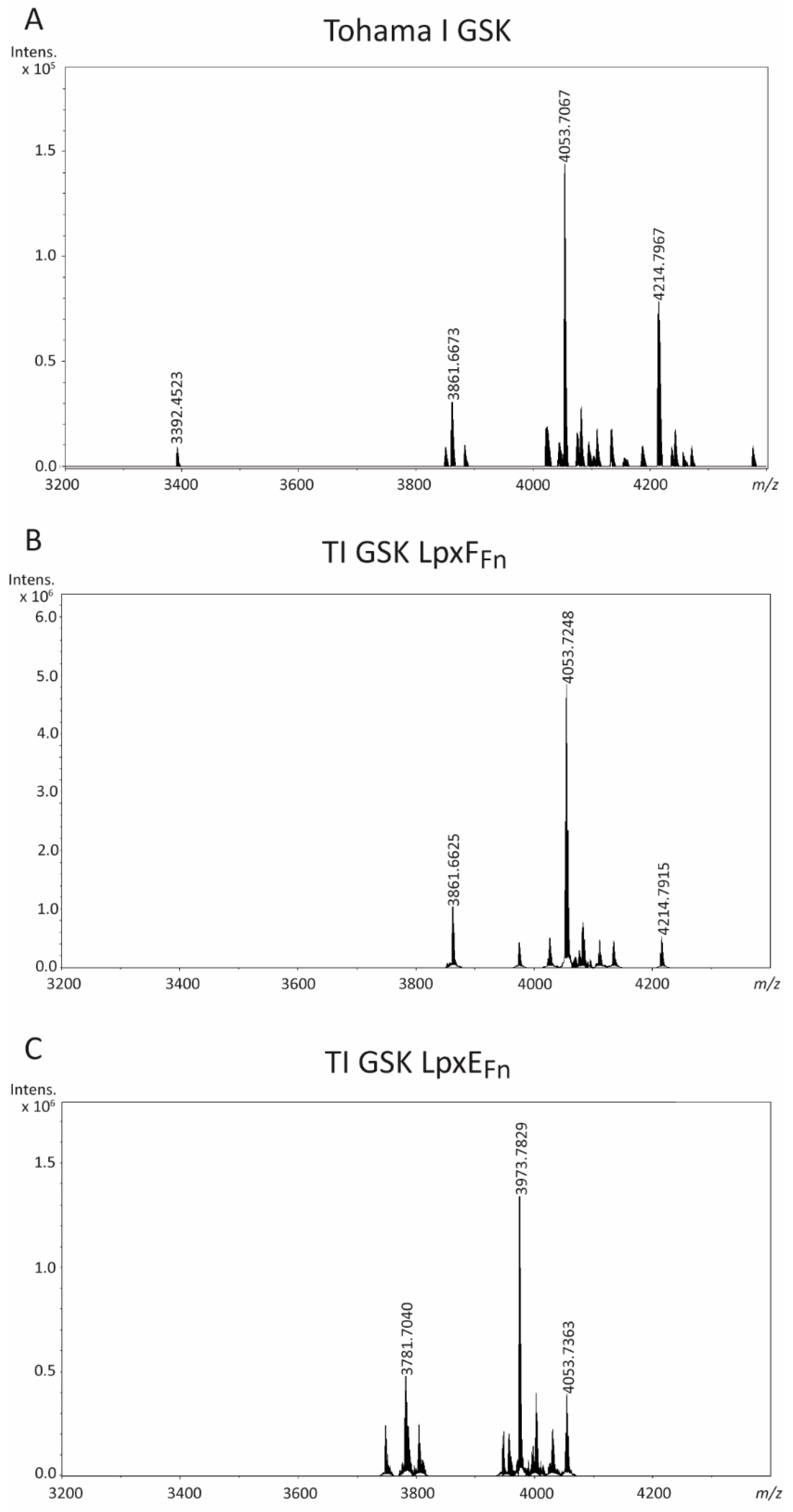
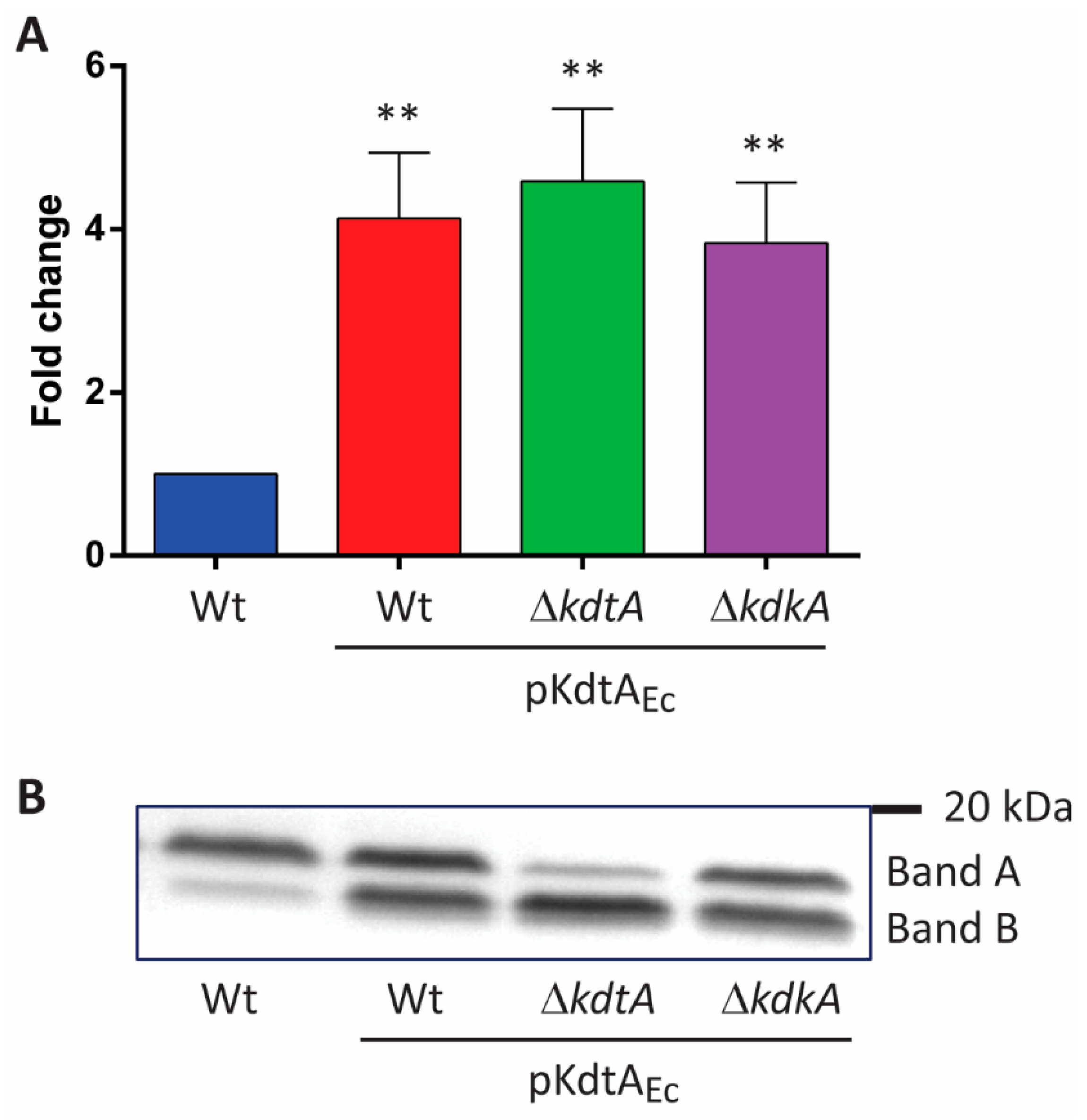

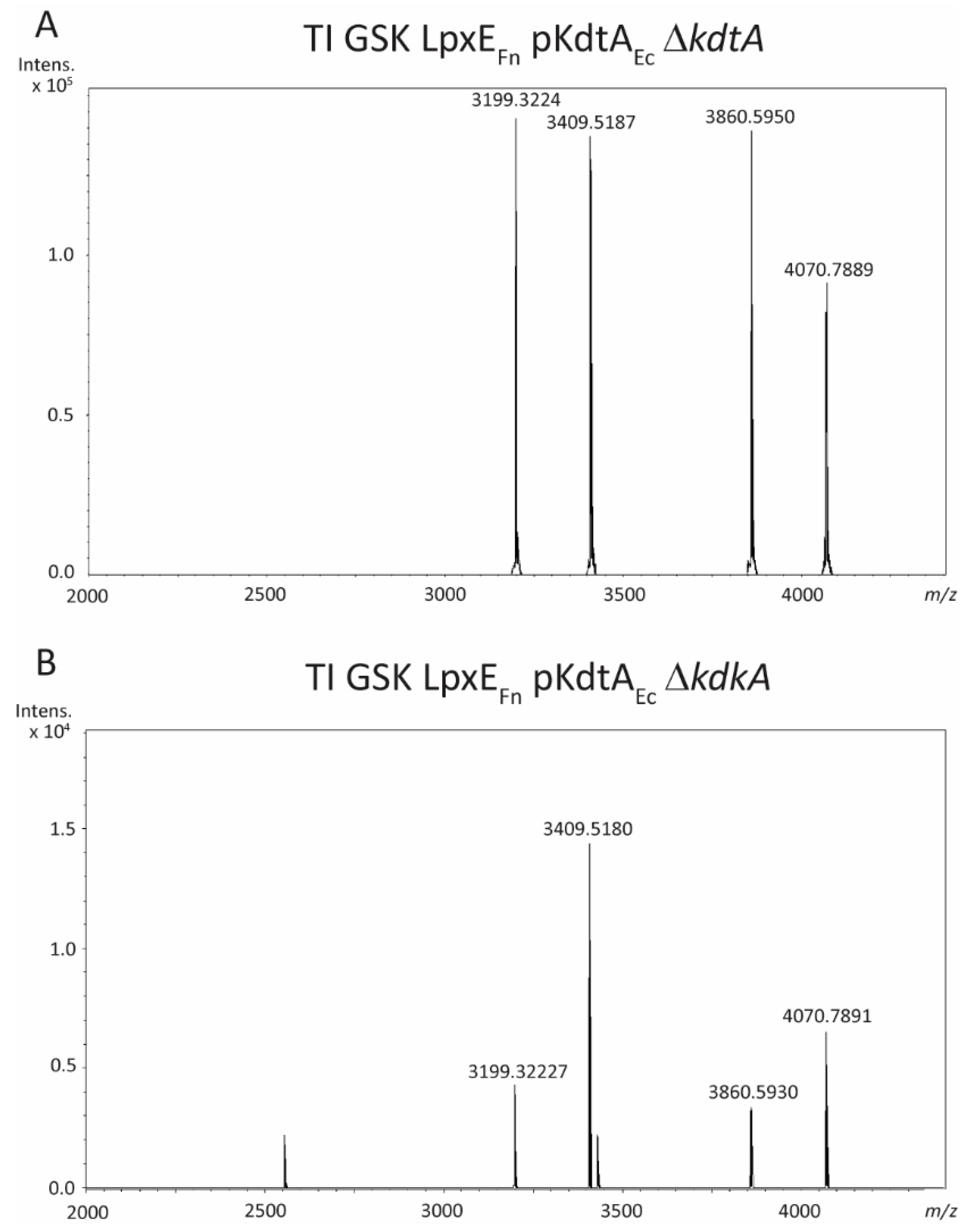

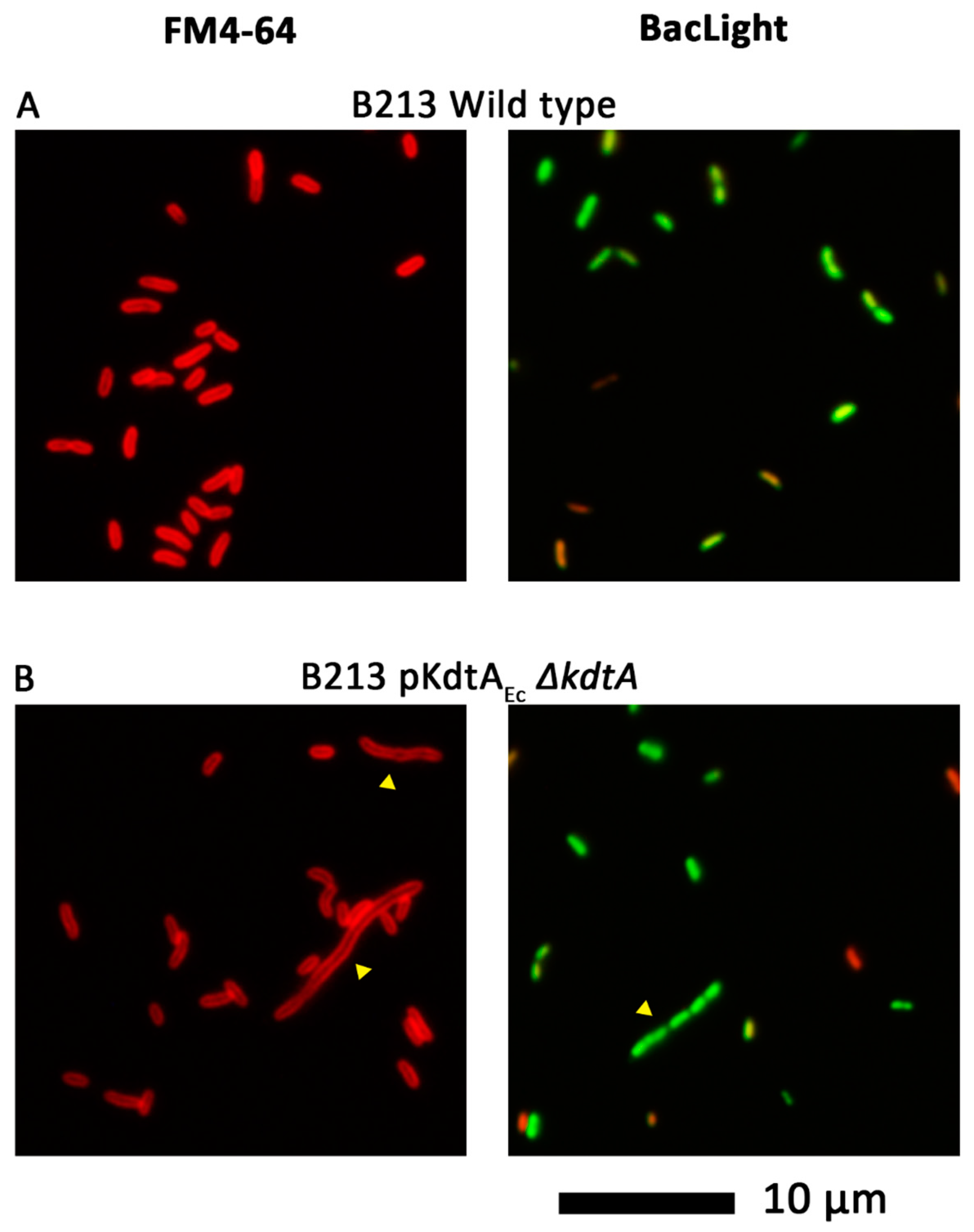
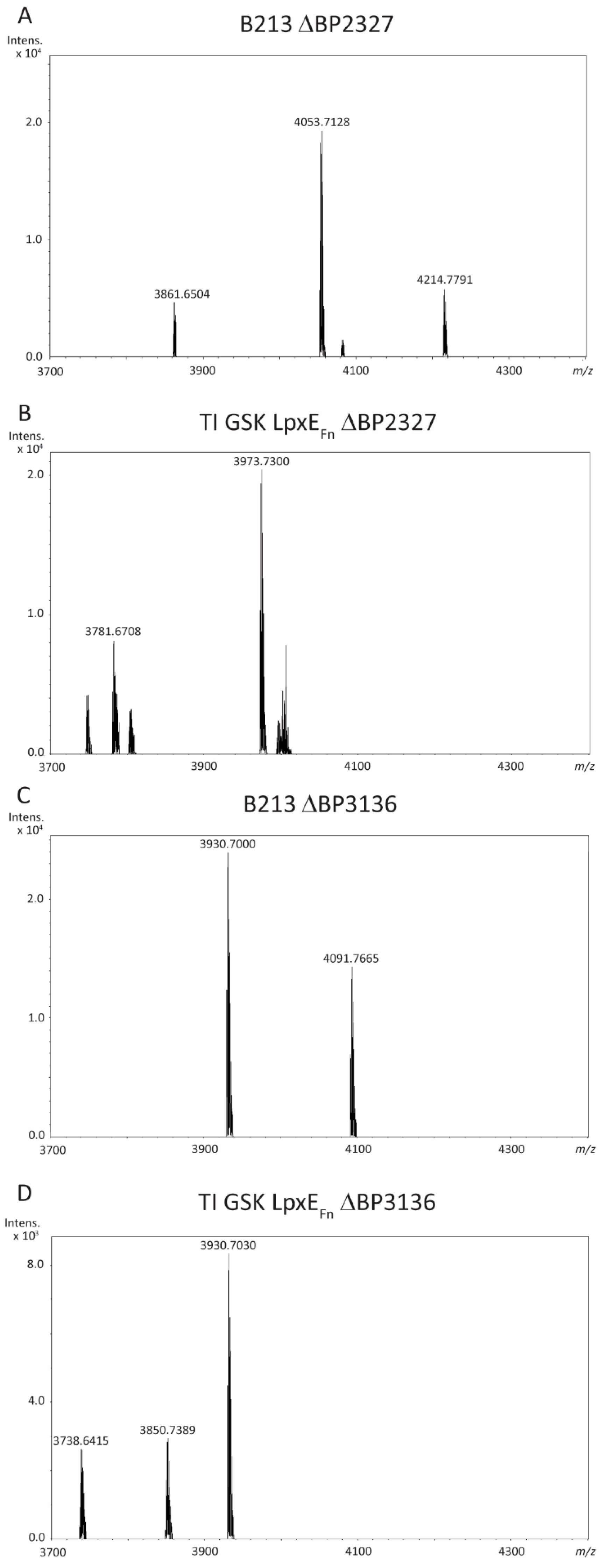
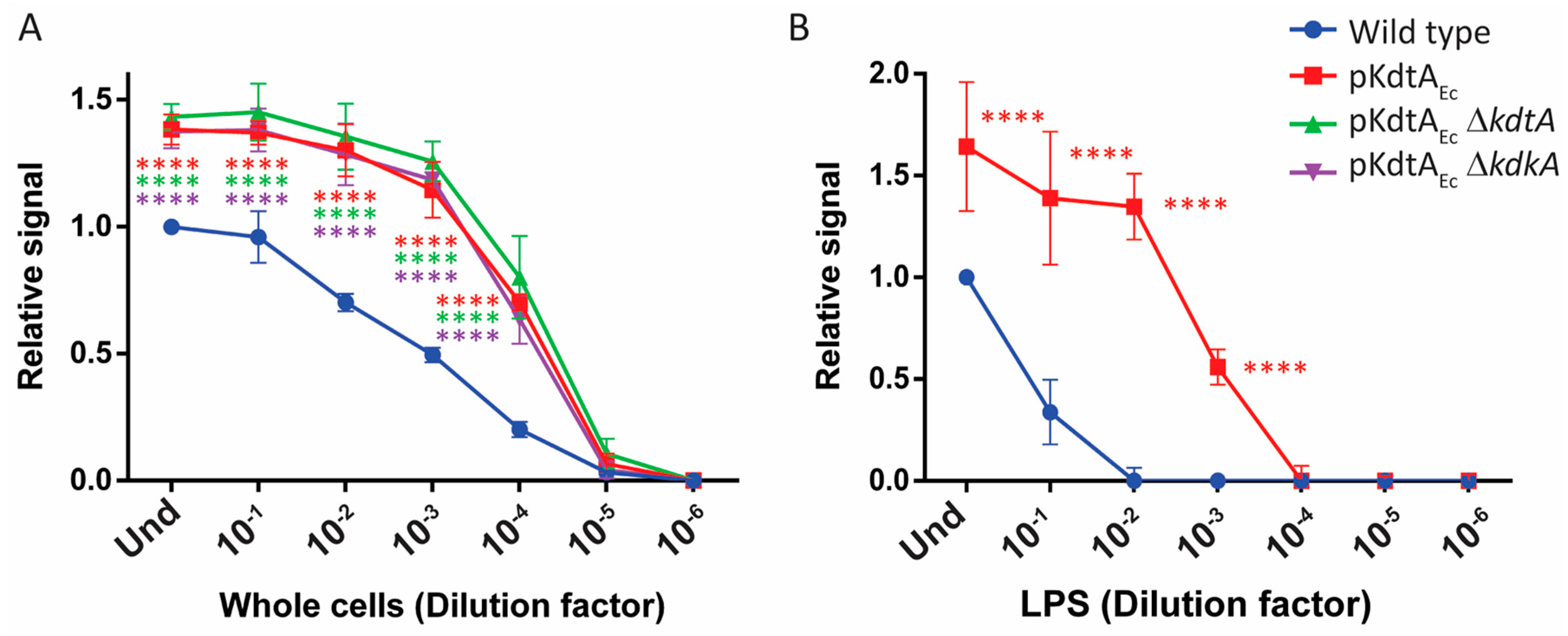
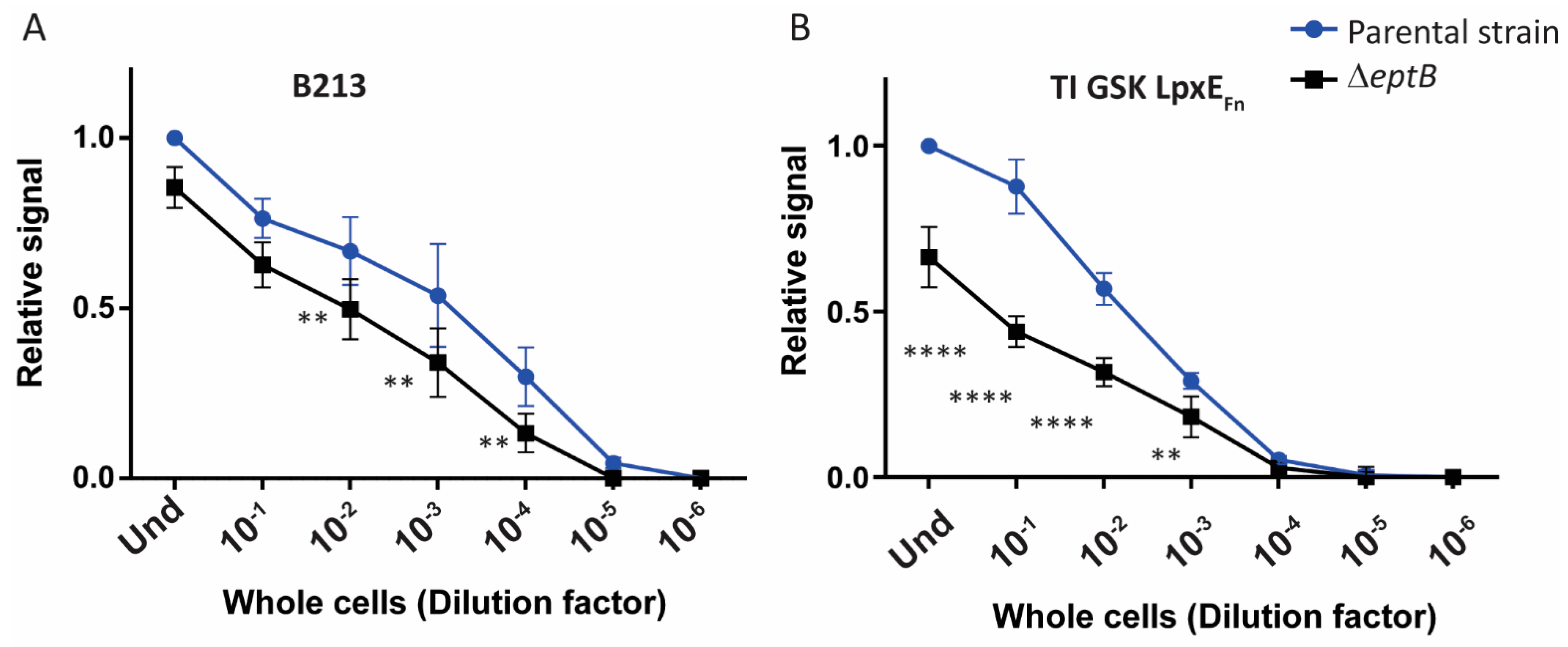
| Figure | Strain | Measured Monoisotopic Mass [M-H]− | Calculated Monoisotopic Mass [M-H]− | Mass Error (ppm) | Proposed Composition |
|---|---|---|---|---|---|
| 2A | Tohama I GSK | 40,537,067 | 40,537,570 | −12 | Wt (TerTri a∙ GalNA∙ Glc∙ GlcN2∙ GlcA∙ Hep3∙ PPEA∙ Kdo∙ lipid A) |
| 38,616,673 | 38,616,936 | −7 | Wt -Hep | ||
| 42,147,967 | 42,148,258 | −7 | Wt +GlcN | ||
| 33,924,523 | 33,924,764 | −7 | Wt -TerTri | ||
| 2B | TI GSK LpxFFn | 40,537,248 | 40,537,570 | −8 | Wt |
| 38,616,625 | 38,616,936 | −8 | Wt -Hep | ||
| 42,147,915 | 42,148,258 | −8 | Wt +GlcN | ||
| 2C | TI GSK LpxEFn | 39,737,829 | 39,737,907 | −2 | Wt-P |
| 37,817,040 | 37,817,273 | −6 | Wt -Hep -P | ||
| 40,537,363 | 40,537,570 | −5 | Wt | ||
| 4A | B213 | 40,536,929 | 40,537,570 | −16 | Wt |
| 42,147,700 | 42,148,258 | −13 | Wt +GlcN | ||
| 38,616,441 | 38,616,936 | −13 | Wt -Hep | ||
| 33,924,317 | 33,924,764 | −13 | Wt -TerTri | ||
| 4B | B213 pKdtAEc ΔkdtA | 34,095,180 | 34,095,598 | −12 | Wt -PPEA -TerTri +Kdo |
| 40,707,891 | 40,708,405 | −13 | Wt -PPEA +Kdo | ||
| 5A | TI GSK LpxEFn pKdtAEc ΔkdtA | 34,095,187 | 34,095,598 | −12 | Wt -PPEA -TerTri +Kdo |
| 31,993,224 | 31,993,615 | −12 | Wt -PPEA -TerTri +Kdo -C14 | ||
| 38,605,950 | 38,606,421 | −12 | Wt -PPEA +Kdo -C14 | ||
| 40,707,889 | 40,708,405 | −13 | Wt -PPEA +Kdo | ||
| 5B | TI GSK LpxEFn pKdtAEc ΔkdkA | 34,095,183 | 34,095,598 | −12 | Wt -PPEA -TerTri +Kdo |
| 40,707,872 | 40,708,405 | −13 | Wt -PPEA +Kdo | ||
| 38,605,930 | 38,606,421 | −13 | Wt -PPEA +Kdo -C14 | ||
| 31,993,227 | 31,993,615 | −12 | Wt -PPEA -TerTri +Kdo -C14 | ||
| 8A | B213 ΔBP2327 | 40,537,128 | 40,537,570 | −11 | Wt |
| 42,147,791 | 42,148,258 | −11 | Wt +GlcN | ||
| 38,616,504 | 38,616,936 | −11 | Wt -Hep | ||
| 8B | TI GSK LpxEFn ΔBP2327 | 39,737,300 | 39,737,907 | −15 | Wt -P |
| 37,816,708 | 37,817,273 | −15 | Wt -Hep -P | ||
| 8C | B213 ΔBP3136 | 39,307,000 | 39,307,485 | −12 | Wt -PEA |
| 40,917,665 | 40,918,173 | −12 | Wt +GlcN -PEA | ||
| 8D | TI GSK LpxEFn ΔBP3136 | 39,307,030 | 39,307,485 | −12 | Wt -PEA |
| 38,507,389 | 38,507,822 | −11 | Wt -PEA -P | ||
| 37,386,415 | 37,386,851 | −12 | Wt -Hep -PEA |
Disclaimer/Publisher’s Note: The statements, opinions and data contained in all publications are solely those of the individual author(s) and contributor(s) and not of MDPI and/or the editor(s). MDPI and/or the editor(s) disclaim responsibility for any injury to people or property resulting from any ideas, methods, instructions or products referred to in the content. |
© 2023 by the authors. Licensee MDPI, Basel, Switzerland. This article is an open access article distributed under the terms and conditions of the Creative Commons Attribution (CC BY) license (https://creativecommons.org/licenses/by/4.0/).
Share and Cite
Pérez-Ortega, J.; van Boxtel, R.; Plisnier, M.; Ingels, D.; Devos, N.; Sijmons, S.; Tommassen, J. Biosynthesis of the Inner Core of Bordetella pertussis Lipopolysaccharides: Effect of Mutations on LPS Structure, Cell Division, and Toll-like Receptor 4 Activation. Int. J. Mol. Sci. 2023, 24, 17313. https://doi.org/10.3390/ijms242417313
Pérez-Ortega J, van Boxtel R, Plisnier M, Ingels D, Devos N, Sijmons S, Tommassen J. Biosynthesis of the Inner Core of Bordetella pertussis Lipopolysaccharides: Effect of Mutations on LPS Structure, Cell Division, and Toll-like Receptor 4 Activation. International Journal of Molecular Sciences. 2023; 24(24):17313. https://doi.org/10.3390/ijms242417313
Chicago/Turabian StylePérez-Ortega, Jesús, Ria van Boxtel, Michel Plisnier, Dominique Ingels, Nathalie Devos, Steven Sijmons, and Jan Tommassen. 2023. "Biosynthesis of the Inner Core of Bordetella pertussis Lipopolysaccharides: Effect of Mutations on LPS Structure, Cell Division, and Toll-like Receptor 4 Activation" International Journal of Molecular Sciences 24, no. 24: 17313. https://doi.org/10.3390/ijms242417313
APA StylePérez-Ortega, J., van Boxtel, R., Plisnier, M., Ingels, D., Devos, N., Sijmons, S., & Tommassen, J. (2023). Biosynthesis of the Inner Core of Bordetella pertussis Lipopolysaccharides: Effect of Mutations on LPS Structure, Cell Division, and Toll-like Receptor 4 Activation. International Journal of Molecular Sciences, 24(24), 17313. https://doi.org/10.3390/ijms242417313







